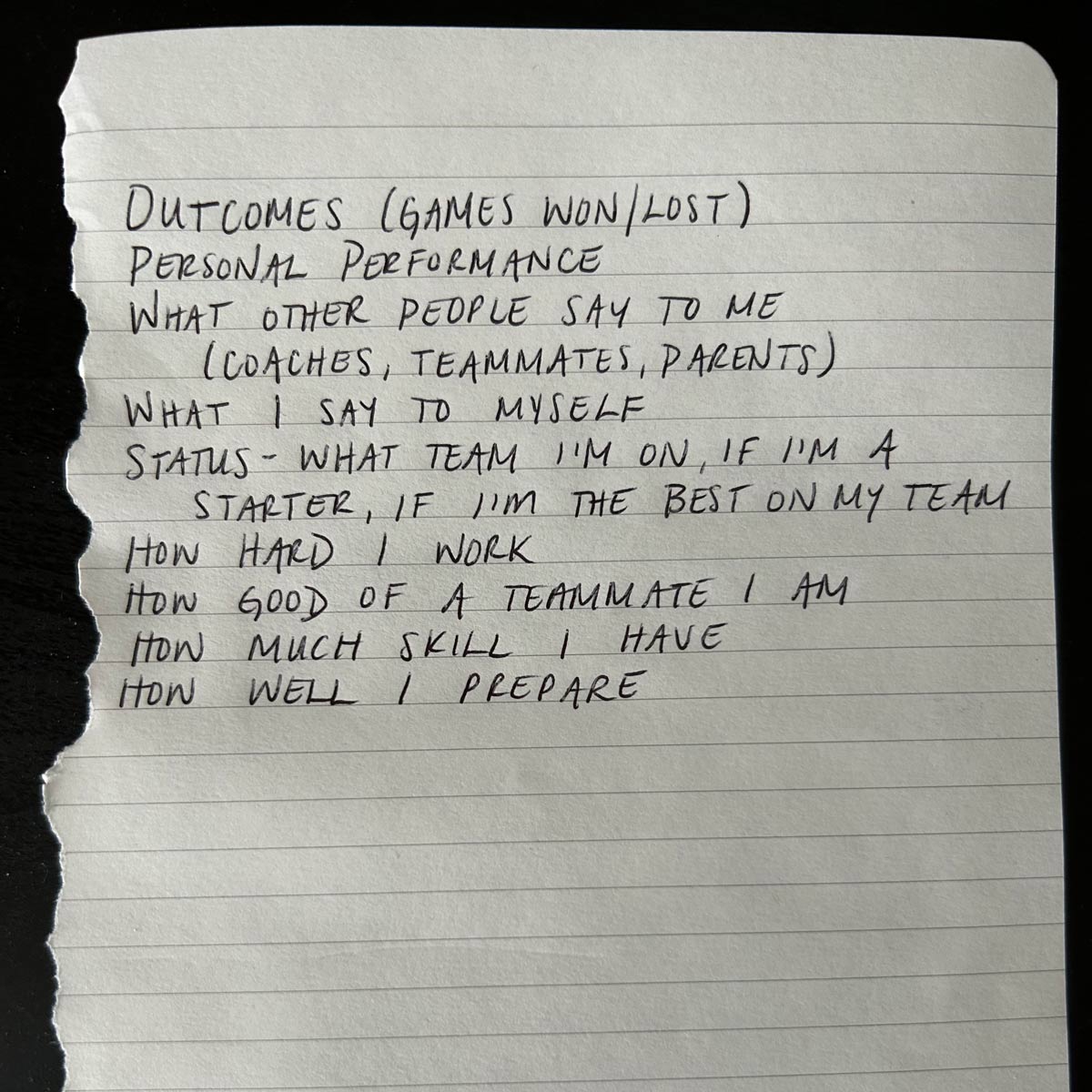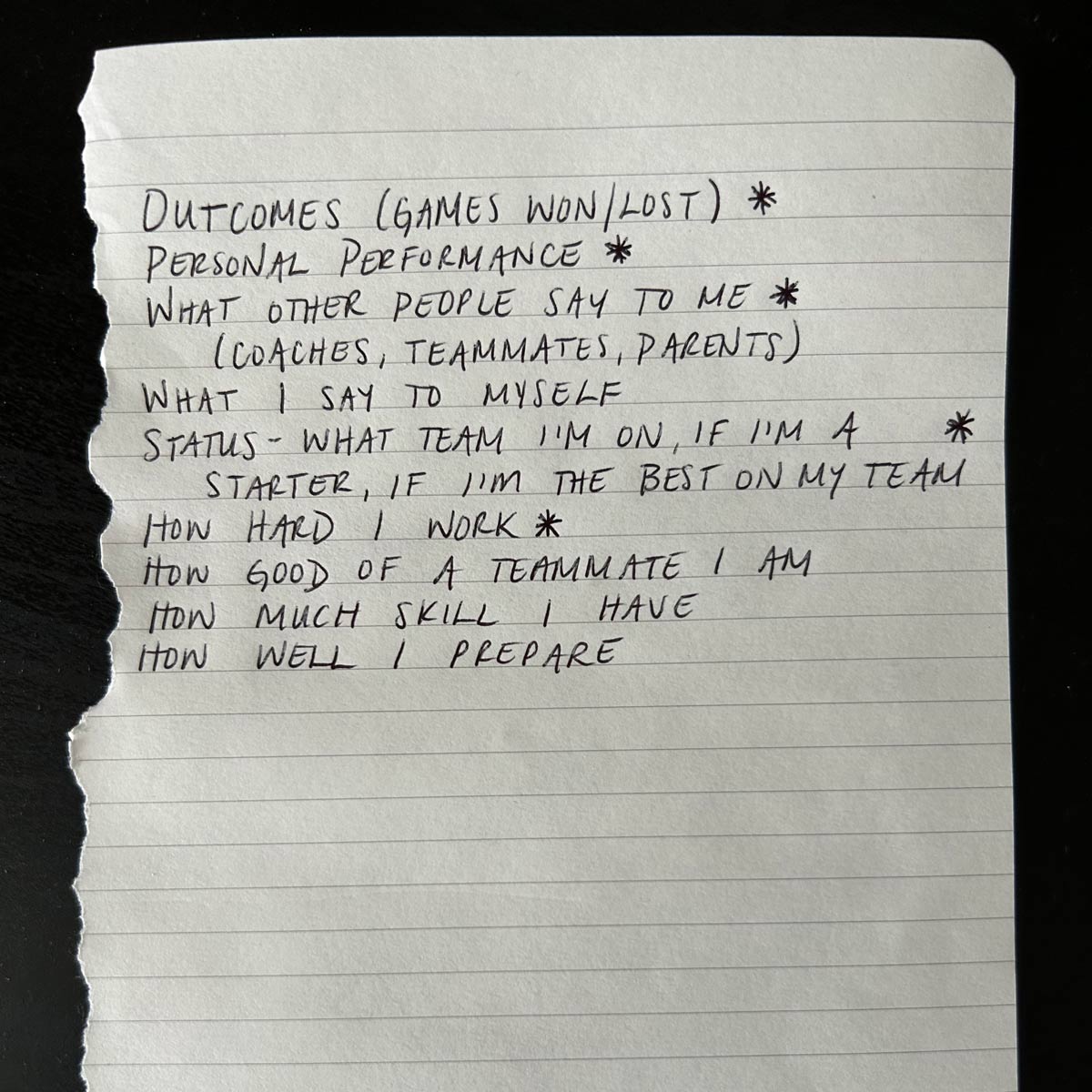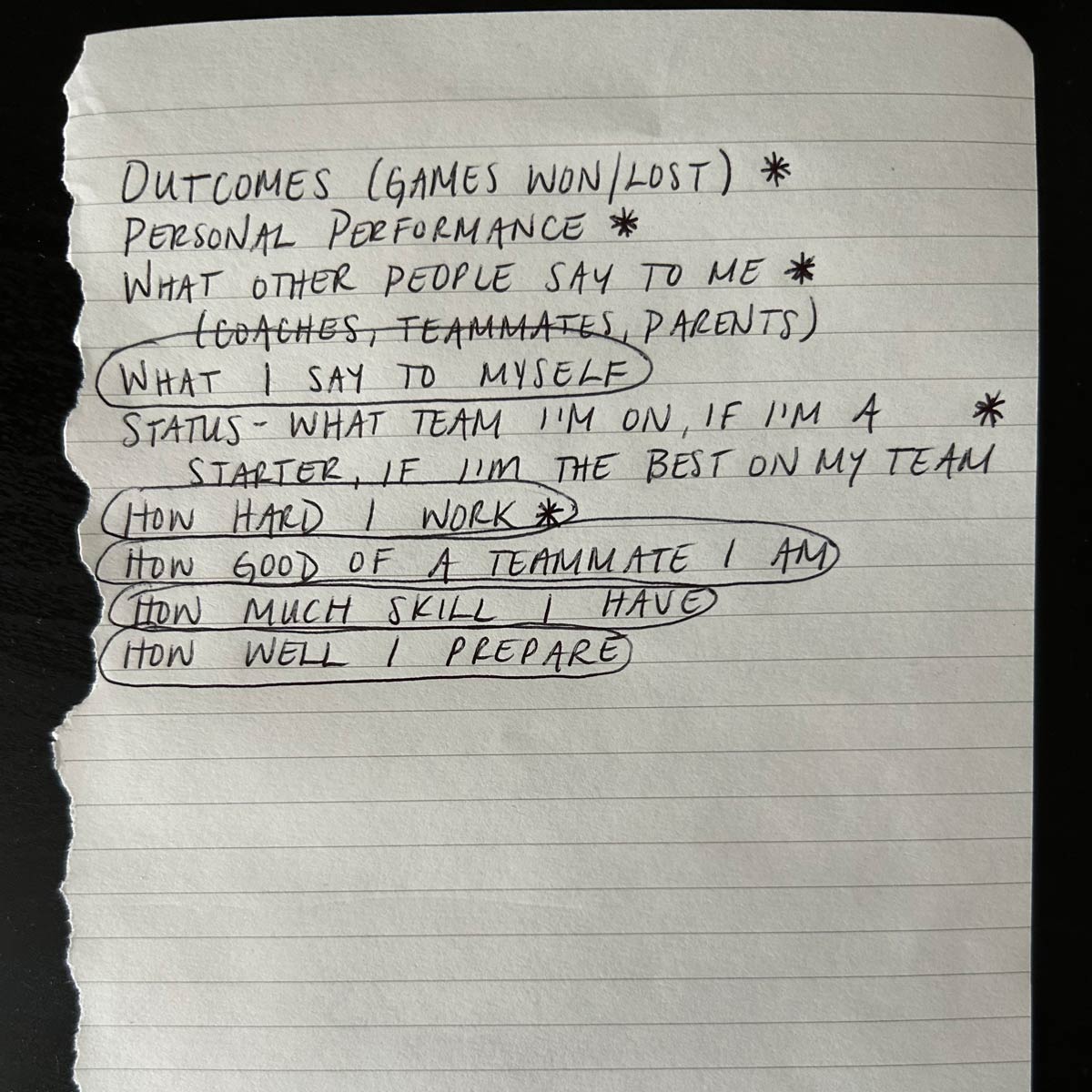What I have always loved about the application of Sport Psychology is that it lies at the crossroads of art and science. It demands from its practitioners both a deep knowledge of theory and research and a healthy dose of creativity and authenticity; without the former, the work would lack efficiency and impact. Without the latter, it would be impossible to successfully adapt and apply the theory to each unique human that sits across from us. As someone who is equally passionate about Latin word origins and well-danced broadway numbers, it’s easy to see why the field resonated with me. What this means for athletes, though, is that every Sport Psych practitioner you encounter will have a slightly – or drastically – different take on the core ingredients of high performance.
Thankfully, though, nearly everyone can agree on a handful of constructs. One such characteristic? Confidence. Time and again, I see youth and adolescent athletes struggle with unstable and improperly sourced confidence. The world of youth sports today, is rife with hyper-comparison, anxiety, perfectionism, and subpar relationships with failure, all of which coalesce into confidence issues. With that in mind, it is high time we put confidence under the microscope: What is it, what impacts it, and how do we build it? Trust me (see what I did there?); this blog has it all.
Dissecting Confidence
Last month, I likened confidence to motivation; though we should expect it to wane every now and again, the odyssey that is high performance can be grim – and even cut short – without it. High levels of self-confidence (and related constructs like optimism) are linked to several characteristics that serve athletes on and off the field, including increased resilience, authenticity, focus, and motivation; greater capacity for personal connection and managing setbacks and failure; and lower levels of anxiety and depression. I don’t know about you, but I’ll gladly take all of those gains on and off the field; thank you very much!
Dimensions of Self-Confidence
For some of us, reading through those benefits can be a bit disheartening because we don’t regard ourselves as “naturally” confident people. We all know those people, the ones that can walk into any room and be themselves, that are always willing to try something new, seemingly without fear of failure or judgment. We also know that these people are the worst. (I kid.) Such individuals are high in global self-confidence. This dimension of confidence is more of an ingrained personality trait; it doesn’t necessarily reflect a belief in our ability to improve or succeed as much as a general willingness to be ourselves and to try. And, some of us are, indeed, born with a bit more of it.
But: Fear not! The benefits of confidence can still be reaped by all thanks to what research indicates is a far more powerful dimension of confidence: Situation-specific self-confidence (SSSC), one’s belief in their ability to succeed at a certain task. Far more dynamic, SSSC can be fostered over time and, in turn, boost global self-confidence. What’s more, when it comes to predicting behavior, SSSC wins out. For instance, despite identifying as high in global self-confidence, if volunteers were sought from CRYSC staff to take part in a juggling competition, my feet would stay firmly on the ground. My lack of SSSC as a non-soccer player in a sea of soccer pros would override my global self-confidence. All of this to say: SSSC is the name of the game. No matter how you regard yourself in terms of global self-confidence, you can reap all of the benefits accompanying high self-confidence through cultivating, in this case, sport-specific self-confidence.
The Confidence Spectrum
Like motivation, sport-specific self-confidence (confidence, moving forward) exists on a spectrum. On one end lies self-doubt. In the middle is confidence, which means a firm trust in oneself. Advancing past confidence brings us to the often dangerous territory of arrogance or cockiness. This risky space lends an exaggerated sense of our own ability, which is actively detrimental to efficient growth and consistent performance. I often see athletes move erratically across this spectrum as a reaction to outcomes or input from others. While our confidence will naturally ebb and flow a bit, the target is honestly built, high self-confidence (without teetering into cockiness) that remains relatively stable, or improves, throughout a season. How do we hit this somewhat finicky bullseye? Well, it’s certainly a team effort.
Cultivating Honest Confidence
I’ll level with you: There are a ton of factors, internal and external, that have the power to influence confidence (for better or worse). While the ownership of fostering sound confidence lies primarily with the athlete, coaches, and caregivers can certainly make their job of growing and sustaining confidence easier, or more difficult.
Athletes: You Are in Charge!
First things first: Go ahead and grab a pen and a piece of paper. I’ll wait here.
Ok, got it? Fantastic. Now: Write down all of the different sources from which you could draw confidence in soccer. Not necessarily where you do, or where you think you should, but where you could.
Alrighty. I can already tell you’re doing great work. Go you! Here’s what I drew up:

Your list is likely different from mine, but I bet we have some crossover. Next, comb through both lists and highlight which sources you most often draw your confidence from. This is an important step because it raises our awareness of our current relationship with confidence. If you’re anything like most young athletes, your list ends up looking something like this:

Finally, review our lists one last time and circle which sources you consider the best to draw confidence from. Remember: We’re aiming to cultivate confidence that is honest, stable, and reliable across any training or game situation. What did you land on? How did you arrive at that decision? Here is what my final list looks like:

Why did I choose these? Firstly, they are all entirely within my control, no matter the situation. Secondly, all of these factors can be depended on to maintain, or even naturally improve, throughout a season.* Thirdly, they’re honest; only I know how much effort I put in, how well I prepare, and how productive my self-talk is leading up to and within competition.
You may notice that the sources from which you draw confidence are misaligned with those you regard as the best. Not to worry. Because here is what they aren’t telling you (whoever “they” is): Only one person gets to decide where you draw confidence from. You. You can choose what fills up and empties your confidence bucket. Shifting away from outcomes and praise toward skill level and preparation takes time and intentional effort. It isn’t easy. Ultimately, it comes down to consciously rewriting your narrative around confidence. Remind yourself every day where you pull your confidence from. Reflect after practice on how you did on those metrics, and gauge your confidence accordingly. Shift your narrative, and then put in the daily work to grow honest confidence; engage in quality practice, be mindful of your self-talk, and work hard every day.
In addition to rewriting your confidence narrative, here are a few more tips you can use to build honest confidence:
- Hunt Good Stuff: Our brain tends to hold on tighter to our mistakes than our successes. After every practice or game, write down three things you improved on, put good effort toward, or executed well. Make them as specific as you can. Not only will this process build confidence, but you will also end up with dozens of unique data points that, when reviewed, will remind you of all the reasons you must be confident on the field.
- Create a Highlight Reel: You know those reels that they play on ESPN after a big game? With the slow-motion finishes, clutch passes, and celebration close-ups all set to an epic backing track? Make one for yourself. While you can do that literally, should you have the resources and skill, constructing one mentally is just as effective. Pick a number of highlights from recent performances, and cut them together in your head. Make the picture as clear as possible and add to your reel as often as you can. Then, watch it back. Doing so will boost your confidence in the moment and efficiently build honest confidence in the long term.
- Train Your Mind: Confidence is closely related to a number of other mental constructs. It is easier to be confident when we have done the work to foster intrinsic motivation, taken time to set and pursue quality goals, adopted a growth mindset, built a workable relationship with failure, and learned how to manage tough emotions. For every hour you physically train, take ten minutes to train mentally. In doing so, you will become a more mentally strong and agile athlete.
Coaches: You Shape The Environment
Whether or not sport helps kids grow self-confidence largely depends on the nature of the athlete’s environment. The environment in which you are the architect, janitor, and bodyguard. Make it easier for athletes to build confidence by creating spaces where they are given opportunities to succeed, fail, and problem-solve. Define success as delivering on factors within an athlete’s control, like their effort, focus, decision-making, and skill development, and direct your feedback accordingly. Build quality relationships with your athletes, so that they feel comfortable being themselves. Promote sound self-awareness (the foundation of honest confidence) by providing compassionate and constructive feedback. Remind athletes that they get to choose where their confidence comes from, and discourage them from giving any coach the power to take it away.**
Parents: You Shape Your Kiddos
If you’ve read any of my blogs, you know what’s coming. Alongside coaches, you as caretakers, play a massive role in your child’s sport experience. Within sport, be a parent, not a coach. Direct praise toward elements within your child’s control, and encourage them to reflect on what they did well over what they struggled with (trust me, they don’t need any help remembering the latter). Zooming out, remember that kids are informed by the way their parent’s frame and respond to the world. Model optimism. Source your own confidence from healthy, honest places. Show your kids you believe in them and their resilience by allowing them to fail without swooping in to save them. Encourage them to move toward things, to put themselves out there and try. Creating these conditions for your kiddo will help them build up their global and situation-specific self-confidence from within.
Go Forth, With Trust!
Training and performing with trust in ourselves and our abilities is a true superpower. It allows us to take more risks, better handle failure, engage more productively with our thoughts and feelings and makes it far more likely that we will reach our full potential as people and performers. Conveniently, it is also a superpower accessible to all of us as long as we put time and effort into cultivating it. So whether you’re an athlete, parent, or coach, I encourage and empower you to take that time and do that work. In doing so, we’ll set the stage for our athletes to get the most out of their sport experience and create a relationship with themselves that will serve them well throughout their lives.
Katie
*I often get pushback for omitting personal performance in this section. Though personal performance is largely within our control and provides us with honest data, even the best performers will have poor outings. It is a normal feature of sport, and by no means a reason to experience a dip in confidence. Amount of skill, on the other hand, dependably increases across a season and remains stable in the face of poor performance. Does the amount of soccer skill you possess change after you make a mistake? No, of course not. Neither, then, should your confidence.
**Some coaches reading this scoff at the idea of such a “soft” environment. However you label it, the reality is that these environments are more conducive to sound athlete confidence, result in greater development and performance, and keep more kids in the game. If those outcomes are considered soft, I’m all for it.









